"백만장자들은 돈을 어디에 보관할까?"라는 궁금증을 가져본 적이 있다면 여러분은 혼자가 아닙니다. 많은 사람들이 부자들의 재정 습관에 대해 궁금해하며, 그럴 만한 이유가 있습니다. 백만장자들이 돈을 관리하는 방법을 더 잘 이해하면 그들의 성공에서 배울 수 있고, 잠재적으로 우리 자신의 재정 상태를 개선하는 데도 도움이 될 수 있습니다.
이번 블로그 포스팅에서는 백만장자들이 부를 축적하고 성장시키는 데 사용할 수 있는 다양한 옵션에 대해 살펴보겠습니다. 전통적인 자산 클래스부터 이색적인 투자까지, 백만장자들이 재산을 보호하고 성장시키기 위해 사용하는 전략을 자세히 살펴볼 것입니다. 돈을 관리하는 새로운 방법을 찾고 있는 백만장자든, 최고로부터 배우고 싶은 백만장자든, 이 포스팅은 여러분에게 도움이 될 것입니다.
Where Do Millionaires Keep Their Money? [It’s Not Where You Think]
If you’ve ever wondered, “Where do millionaires keep their money?” then you’re not alone. Many people are curious about the financial habits of the wealthy, and for good reason. Having a better understanding of how millionaires manage their money can help us learn from their successes and potentially improve our own financial well-being as well.
In this blog post, I’ll explore the various options available to millionaires for storing and growing their wealth. From traditional asset classes to more exotic investments, we’ll take a closer look at the strategies millionaires employ to protect and grow their fortunes. Whether you’re a millionaire looking for new ways to manage your money or just someone who wants to learn from the best, this post has something for you.
How Do Millionaires Invest Their Money?
To figure out how millionaires invest their money, I will be examining the three primary investment decisions that impact their returns (according to the late pioneer of institutional asset management David Swensen):
- Asset allocation: What asset classes do millionaires invest in.
- Market timing: When do millionaires buy/sell those assets.
- Security selection: How do millionaires choose which securities to buy within an asset class.
To do this, I will primarily be relying on Vanguard’s 2020 How America Invests study, which examines how affluent households (those with at least $500,000 in investable assets at Vanguard) invest their money. While not all of the households in this study are millionaires, the vast majority of them are. The median household in the study has over $1 million with Vanguard and those below the median have assets outside of Vanguard (i.e. real estate, non-Vanguard accounts, etc.) that make most of them millionaires as well.
With that being said, let’s address the first part of how millionaires invest—their asset allocation.
What Asset Classes Do Millionaires Own?
According to Vanguard, the asset allocation of a typical millionaire household is:
- 65% Stocks (Equity)
- 25% Bonds (Fixed income)
- 10% Cash
As you can see in the chart below, this allocation has been relatively stable over time as well:
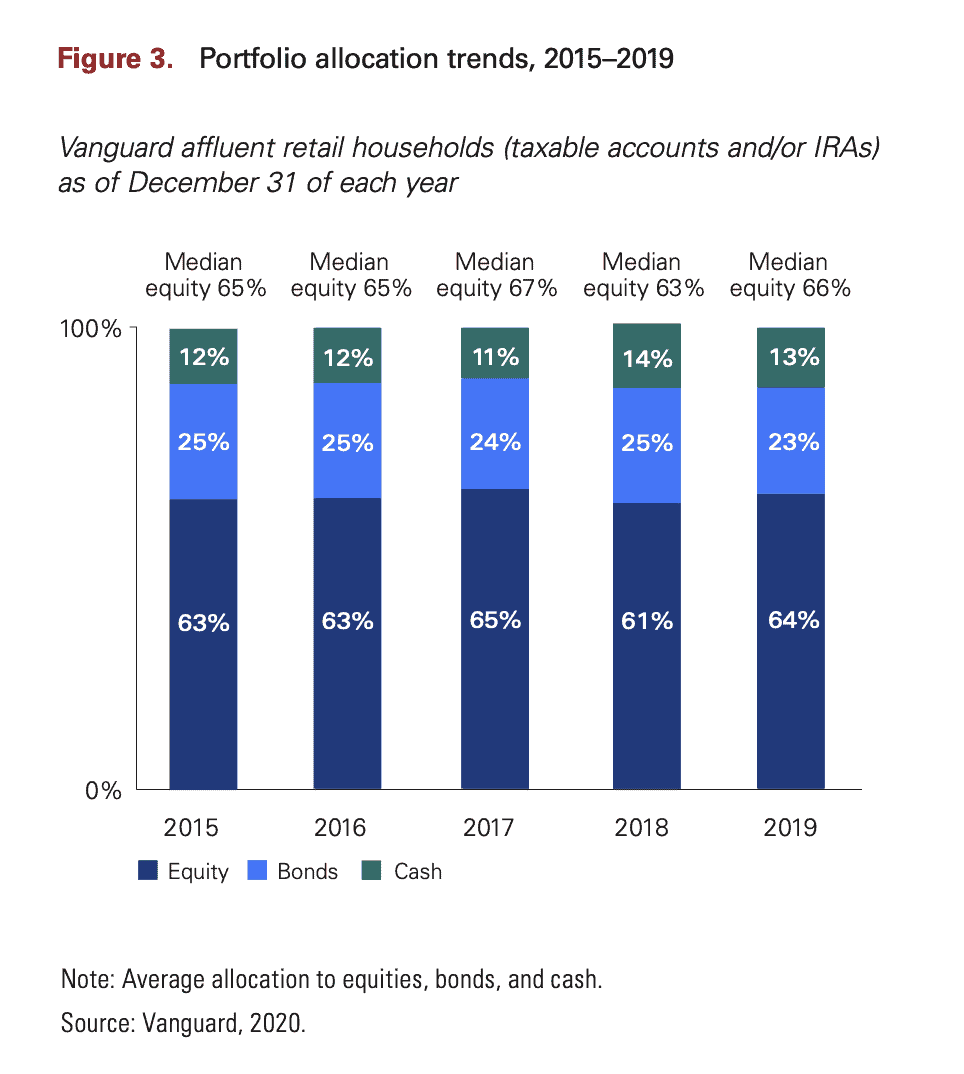
This gives us a good idea of how millionaires tend to invest their money within their investment accounts on average. However, it doesn’t tell us anything about how those allocations change over time within households. Since the chart above is the aggregate allocation across all households, we don’t get to see any age-related allocation changes.
Fortunately, Vanguard provides a breakdown of allocation by household age in their study as well. We can see this in the table below which shows that households under 45 tend to allocate around 75% of their portfolios to equities, while households older than 65 allocate around 60% to equities:
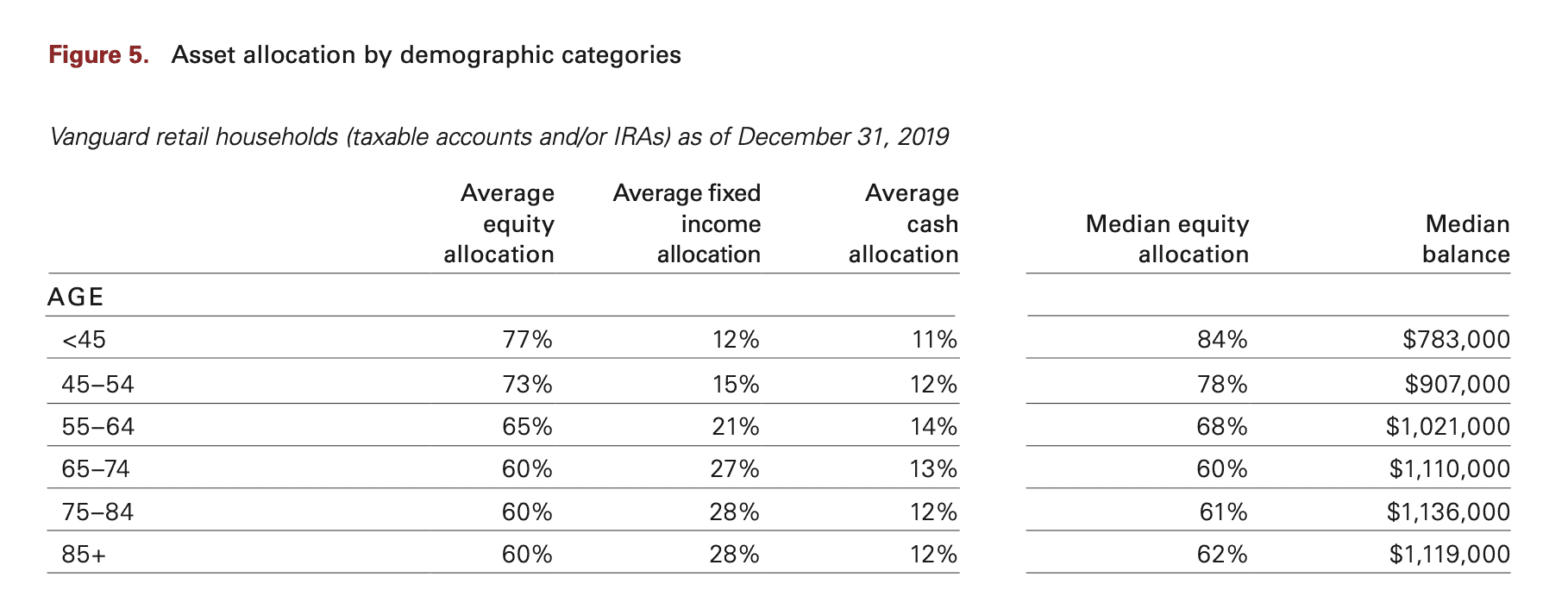
What happens to the money that comes out of equities as these affluent households age? It goes into fixed income.
From the table above, we can see that the fixed income allocation of affluent households nearly doubles from age 50 to age 80. In other words, affluent households tend to go from 15% bonds to 30% bonds as they enter retirement.
But, what about other asset classes? Don’t millionaires invest a lot of money outside of stocks, bonds, and cash? According to the 2017 U.S. Trust Insights on Wealth and Worth, the answer is “Not really.”
As their study shows, high net worth households (those with over $3 million in investable assets) had the vast majority of their wealth in stocks, bonds, and cash, with less than 7% of their investable assets in alternatives:

This suggests that what we see in the Vanguard’s How America Invests study is representative of how the typical millionaire household allocates their money. They own typical asset classes and not all these exotic investments like the financial media might have us believe.
Of course, these studies exclude personal real estate and ownership of an individual business, both which can be significant. As Thomas J. Stanley and William D. Danko stated about the typical millionaire household in The Millionaire Next Door:
On average, 21 percent of our household’s wealth is in our private business.
Once we include ownership of private businesses and real estate, the typical millionaire household’s allocation to traditional asset classes like stocks and bonds is a bit lower that what has been advertised above.
We can see this more clearly if we look at the chart below (from VisualCapitalist), which highlights how household net worth is broken out across different wealth tiers. In it we can see the percentage allocated to a primary residence, vehicles, business interests, and much more:
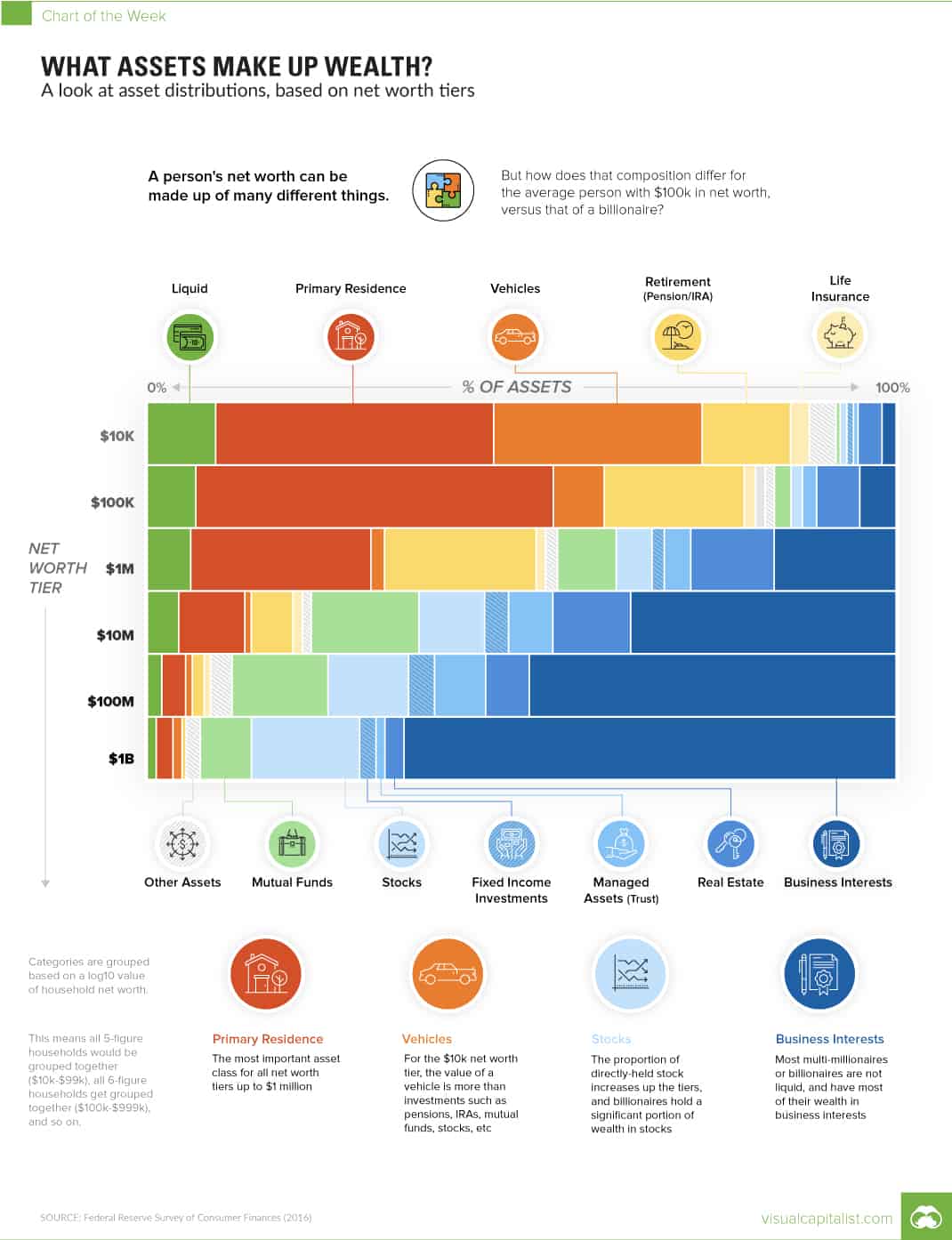
As you can see, millionaire households have about 25% of their wealth in their primary residence and 15% in business interests (trust me I measured the bars). This implies that the typical millionaire has a 60% allocation to stocks, bonds, and cash. More importantly, this percentage seems to decline as households get wealthier. Once you become a decamillionaire or centimillionaire, business interests began to dominate most of your wealth.
Now that we have a rough idea of how millionaires allocate their assets, let’s look at their buy and sell decisions.
Do Millionaires Try to Time the Market?
When it comes to trying to time the market, affluent households are quite tame. As the table below (from Vanguard) illustrates, a little over half of all affluent households traded their accounts within a year, and when they did they only traded about 10% of their total assets:

This suggests that millionaire households aren’t trying to time the market. And this isn’t just an artifact of the relatively calm market stretch from 2015-2019. During the market crash of March 2020, only 11% of Vanguard investors made any active trades.
And this isn’t just a Vanguard thing either. The Millionaire Next Door comes to a similar conclusion when describing the typical millionaire household (emphasis mine):
We hold nearly 20 percent of our household’s wealth in transaction securities such as publicly traded stocks and mutual funds. But we rarely sell our equity investments.
From what I’ve seen between these two data sources, it seems clear to me that most millionaires aren’t trying to time the market in any meaningful way. They invest and let it ride.
Now that we have looked at market timing, let’s examine how millionaires pick which securities to buy within an asset class.
How Do Millionaires Pick Securities Within an Asset Class?
When it comes to how millionaires pick securities within an asset class, the answer is—diversification. If you look at the investment product choices that affluent households make, you will see that the vast majority use mutual funds (which tend to be diversified), with only one third of them owning any individual securities (i.e. individual stocks):
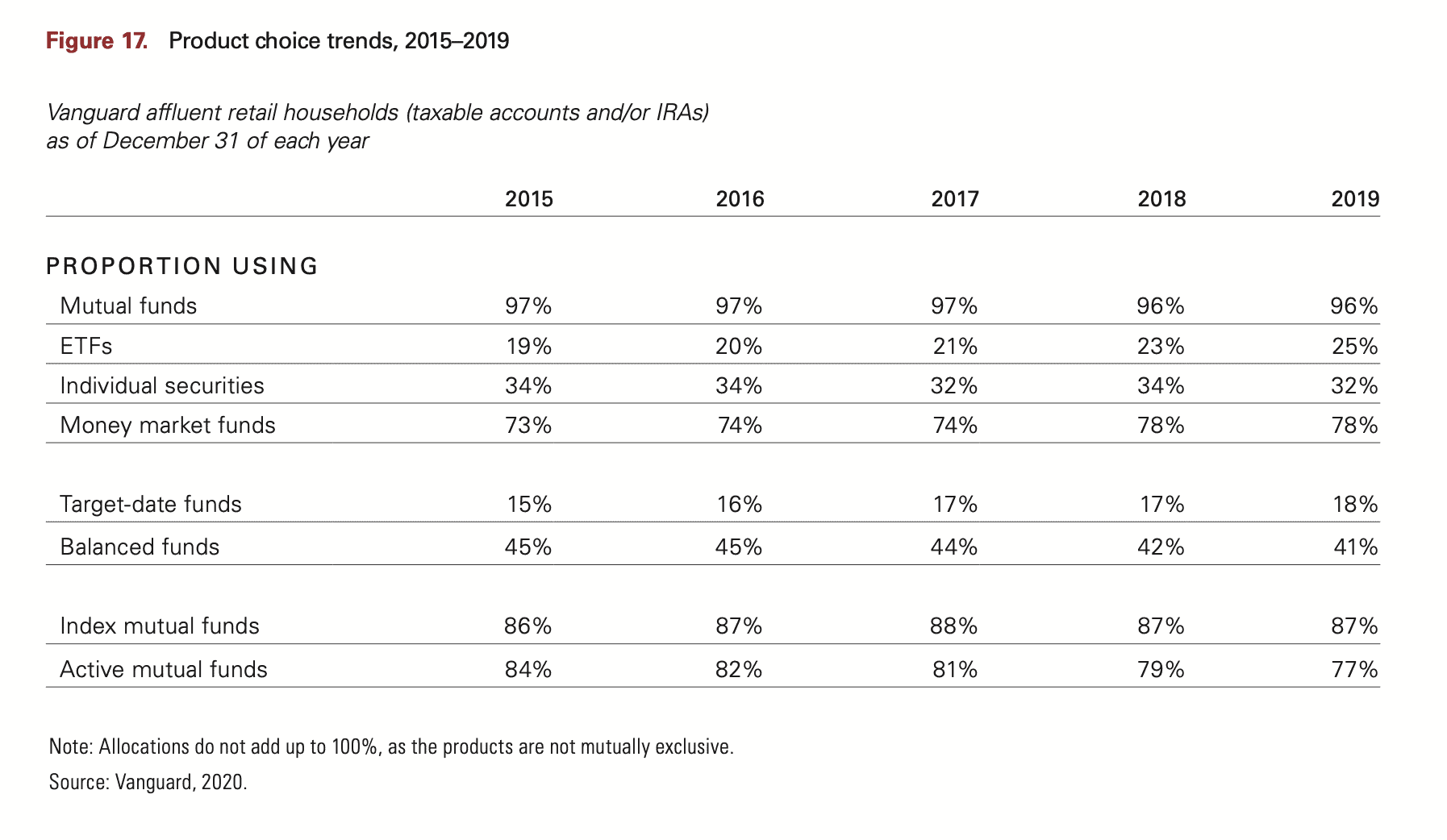
While the vast majority of affluent households diversify through mutual funds, they are not all passive investors. Though the shift to passive funds accelerated from 2015 to 2019, 77% of affluent households still owned an active mutual fund in 2019.
This might surprise you, but this phenomenon is mostly being driven by older households who tend to have more of their wealth in active strategies:
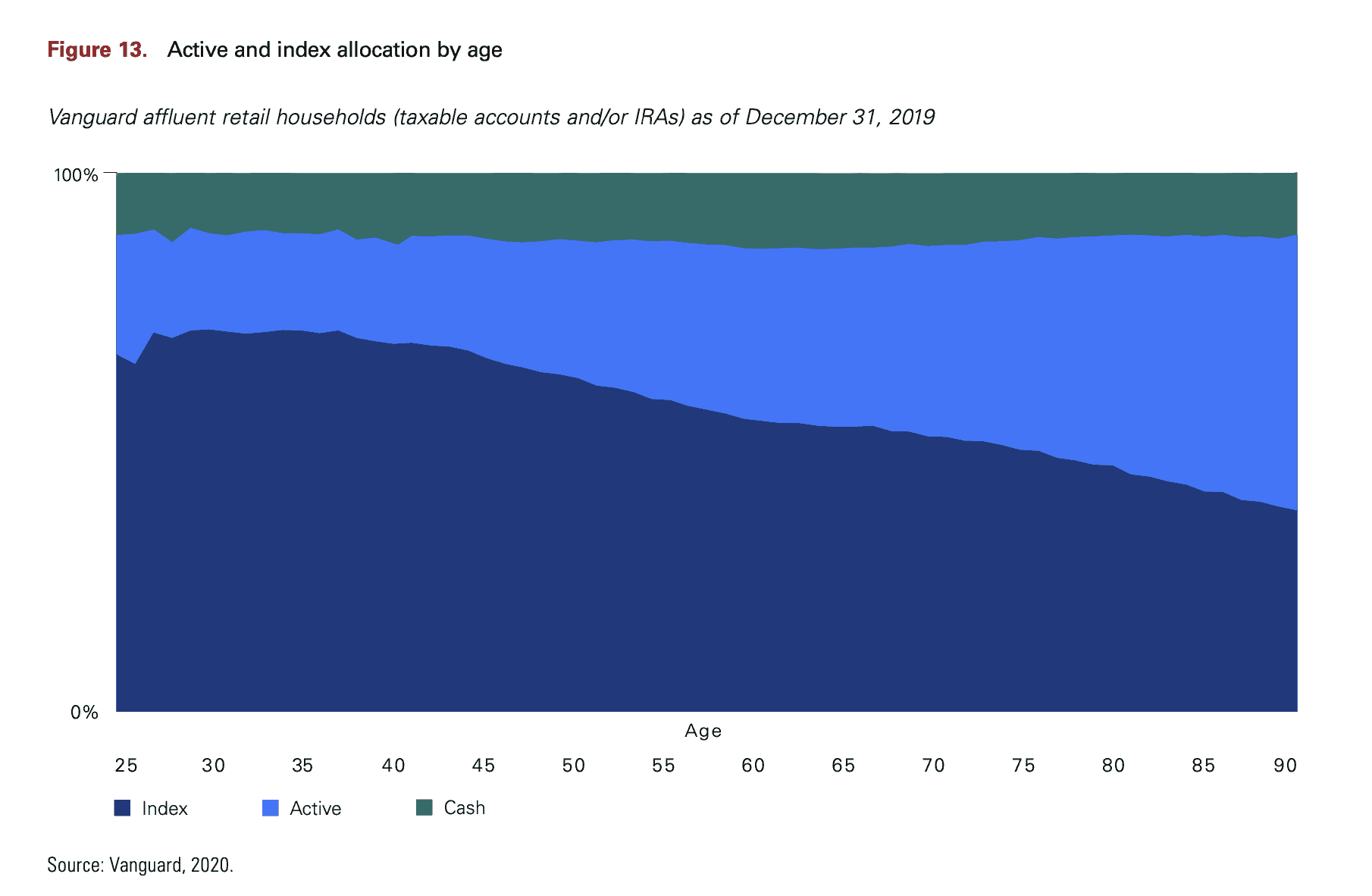 As German scientist Max Planck once said:
As German scientist Max Planck once said:
Science advances one funeral at a time.
Well, the same seems to be true with passive investing. Older investors, who didn’t grow up in the age of mass indexing, don’t seem to have taken to passive in the same way as younger investors as a whole. Therefore, as these older investors pass on, we should see even further adoption of passive investing in the future.
Now that we have looked at the asset allocation, market timing, and security selection decisions of millionaire households, let’s examine whether wealthier millionaires invest the same as their less fortunate counterparts.
Do Wealthier Millionaires Invest Differently?
So far I have focused our analysis on households that are right above the millionaire threshold. But, what about households that have more than just a few million dollars to their name? Do they invest differently than the typical millionaire household?
The evidence suggests that they do. This report from KKR demonstrates that ultra-high net worth investors (those with >$30 million in assets) invest more money into alternatives (i.e. private equity, hedge funds, etc.) and cash than high net worth investors (those with >$1 million in assets).
As you can see in the chart below, ultra-high net worth (UHNW) investors allocated 30% to stocks, 10% to bonds, 50% to alternatives, and 10% to cash while high net worth (HNW) investors allocated around 50% to stocks, 20% to bonds, 25% to alternatives, and 5% to cash:

I can’t necessarily explain why UHNW investors have more money in alternatives, but I have a few theories. One of them is that, as wealth increases, households tend to invest based more on status than returns. Alternative investments like private equity and hedge funds offer a sense of exclusivity that you can’t get with a Vanguard index fund.
Another possibility is that wealthier households invest in alternatives because they are the only ones that can access them anyway. While anyone with a few thousand dollars (sometimes less) can buy an index fund, you need to have serious capital to get into many of these alternatives.
Fortunately, retail investors (i.e. you and I) don’t need alternatives to successfully build wealth. In fact, there’s a decent amount of evidence showing that public investment strategies tend to outperform private strategies, especially after fees are taken into account. For example, the chart below shows the returns generated by hedge funds and the S&P 500 from 2015 to 2021:
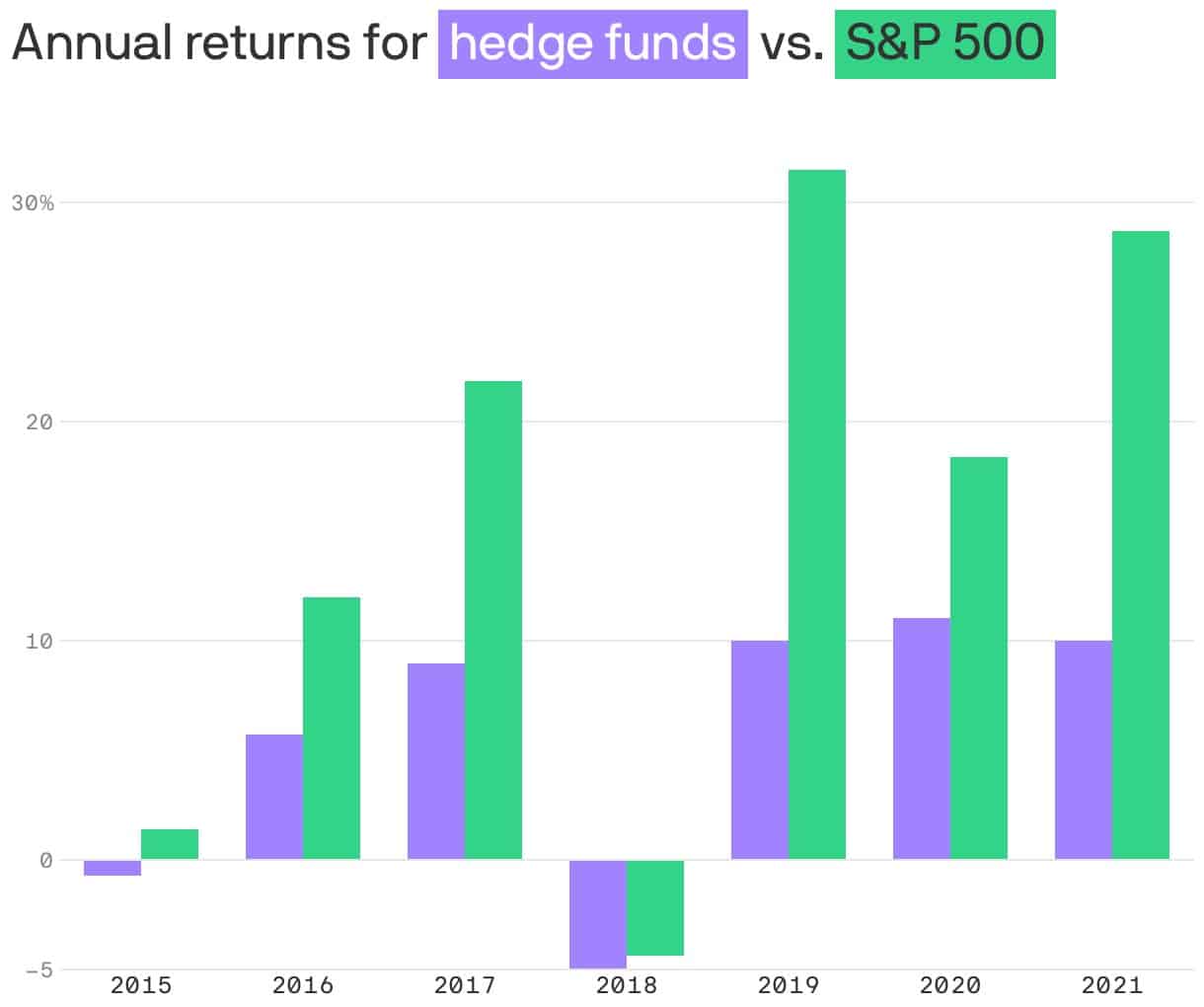
As you can see, the S&P 500 outperformed a basket of hedge funds in every year from 2015-2021. This is even true in 2018, the only down year during this time period! For all those hedge fund defenders that like to say, “But hedge funds will outperform in a down market!” please explain 2018.
Either way, my point stands. There is no evidence that the typical retail investor needs alternatives to build wealth. While investing in alternatives can be nice to brag about at dinner parties, I’m not in the business of bragging. I’m in the business of trying to make you richer.
With that being said, let’s conclude by discussing why investing like a millionaire won’t necessarily make you into one.
Why Investing Like a Millionaire Won’t Necessarily Make You a Millionaire
Throughout this article we have assumed that by emulating how millionaires invest their money, you too will one day become a millionaire. But this isn’t necessarily the case. Why? Because most millionaires don’t become millionaires solely based on their investment decisions. They also tend to have a high income, a high savings rate, or both. And the further you go up the wealth spectrum, the more apparent this becomes.
If you want to become a typical millionaire, like the affluent households in Vanguard’s 2020 How America Invests study, buying a diverse set of income-producing assets and earning 7% a year will work just fine.
However, if you want wealth that is orders of magnitude higher, the S&P 500 ain’t gonna cut it. To obtain extreme levels of wealth you need:
- A very high income (i.e. famous musician/actor/athlete, successful business owner, C-Suite executive, etc.), or
- A huge liquidity event (i.e. sell your business, startup equity IPO, etc.)
Possibly a bit of both. Of course, I don’t know which path will be right for you. But, I do know that investing like a millionaire won’t necessarily make you into one. With that being said, happy investing and thank you for reading!
댓글 없음:
댓글 쓰기